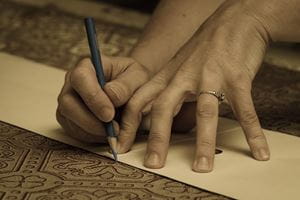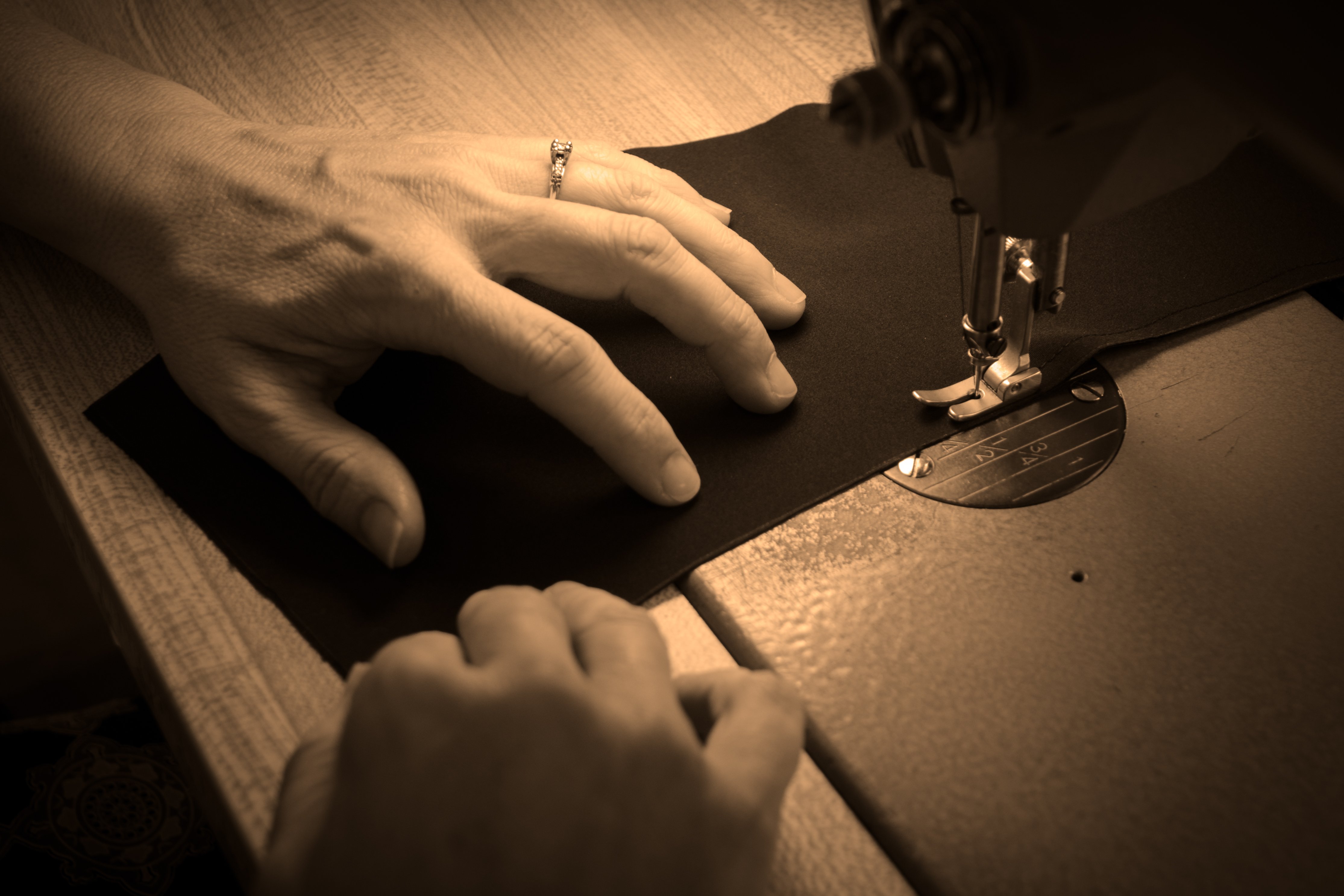
Religion Behind the Scenes spotlights the less discussed, but no less crucial, tasks that keep religious communities running, and the people who make it all happen.
Approximately two-thirds of Christian denominations utilize religious vestments—or liturgical clothing—as part of their worship, and as a means of distinguishing their clergy as holding a special calling or ordination. Roman Catholics, Eastern Orthodox Christians, Anglicans, Lutherans, and others see these as a requisite part of the holy work that ordained clergy are tasked to do.
Of all High-Church traditions, the Eastern Orthodox are, by far, the denomination with the most elaborate, beautiful, and complex set of ecclesiastical vestments. But who makes these? And what does it take to produce a set? What are their symbolic meanings? Ecclesiastical tailor, Krista West, has spent decades researching, writing about, lecturing on, and producing ecclesiastical vestments for the clergy of the Orthodox Church. In this delightful interview, she lets us in on the “behind the scenes” of this fascinating and challenging work.
Since you “sew” vestments for priests, I assume you would be called a “seamstress.” But is that the appropriate or accurate title for your job?
So technically I am an “ecclesiastical tailor.” You could also say “church tailoring,” since a lot of people don’t know the word “ecclesiastical.” That’s a tough word. So, I’ll tell people that I’m a “specialty garment tailor.” You know, I’ll be out, and someone will ask, “What do you do?” And I’m like, “Oh, boy! How long do you have for me to explain this?”
Yeah. So, I make “garments.” They just happened to be garments that are used in churches.
“Vestment Tailor” sounds so much better than “Vestment Maker” to me.
Exactly! And with “vestment maker,” you have to be careful. The first year I submitted my taxes. my accountant (over the phone) thought I was saying I was an “investment banker” instead of a “vestment maker.” I got my taxes back and my occupation was listed as “investment banker,” and I was like, “Dude, I am really bad at investment banking if this is all that I earned for the year.”
So how long have you been an ecclesiastical tailor?
2020 was my 25th year of doing this. I started in 1995, as an apprentice under Leslie Shale. She worked as an ecclesiastical tailor for many, many years A lot of people on the East Coast know her. She was actually trained at the Fashion Institute of Technology in New York—as a pattern drafter. I apprenticed with her for three years before going on my own, which I did with her blessing.
What’s a challenge in vestment making that most people wouldn’t expect?
There are two sides to vestment making, well, really to making any garment. There’s the pattern drafting, and the actual sewing. And so, you have to start with something two-dimensional (a flat pattern) and make out of that something three-dimensional; something that fits the body. So, I was really fortunate to be able to study with Leslie, because she had that pattern drafting foundation, which is critical. You can’t get things to fit if you don’t know how to actually draft the patterns and adapt them to each person’s measurements. So, I worked with her for three years, and then I went on my own right around 1998.
I thought it was just going to be a little hobby business; I would do it on the side. I had a couple of clients at that point. But then the internet happened, and a friend of mine was a web designer. He asked if he could use my site for testing web design principles. And I was like, “Sure!” This is 1998.
Nobody’s buying anything on the Internet at this point. Like, it’s all just scholarly articles at that point. So, we were the very first ecclesiastical tailoring website on the internet. And then things just took off.
Do you mostly make vestments for Eastern Orthodox clergy, or do you create vestments for other religions also?
I only work for Eastern Orthodox clergy. There’s just such a demand, and there are only so many hours in the day. And so, I’ve had to really just specialize. I don’t really have any interest in the western vestment tradition because it’s so reductive now, you know. It’s just basically like these simple or solid colored robes. It’s really plain, from my point of view. I’m not trying to be offensive, but it’s super boring to me.
So, you’ve explained a bit about how you got into ecclesiastical tailoring. This is a slightly more nuanced question; but what drew you to the work of creating liturgical vestments?
Oh, wow. Okay, that’s really easy. So, I grew up doing textiles, from the time I was very tiny—like four or five years old. I was doing sewing, and things like that, and crochet, and different little projects. By the time I was in high school, I pretty much had a continual project of some sort going on in the textile world, like from the time I was probably middle school age. That was kind of the beginning.
Growing up, I was “un-churched.” I’d gone to church, you know. I’d gone to evangelical churches in high school, that sort of thing. But it was a really bad fit for me. And so, my husband—who had grown up Baptist—was like, “Hey, I think there are some other older churches around.” And I’m like, “Yeah, let’s go check em out.” We ended up in the Episcopal Church for about three and a half years. And that was a good fit. I really liked the Episcopal Church. I liked the liturgy. But then we went to an Eastern Orthodox liturgy. It’s funny, because it wasn’t that exciting of a liturgy, and it wasn’t architecturally that great of a church space either. Nothing was really that aesthetically great, but it still just blew me away. The whole package deal really just spoke to me. And, for me, it was like literally an instantaneous conversion. I’m like, “Okay, I’m in! Where do I sign?” And it was the vestments that drew me. I remember thinking, “Wait, wait, church vestments can look like this?” because, you know, even in the Episcopal Church, there were a lot of very simple vestments, kind of the whim of whatever the modern aesthetic was that year; and a lot of stuff that really doesn’t stand the test of time. And I felt like, when I came into an Orthodox Church, it was awesome. This is a church I can die in! Because I’m pretty certain this church is going to look the same once I’m old enough to die. So, we’re all good. So, that was really my conversion; but it was it was very much influenced by the textiles.
I always like to say that for us, as Orthodox Christians, when it comes to our aesthetics, “More is more!” So, let’s just do more! The Russian scholar, Dr. Alexei Lidov, has called the Byzantine liturgy a “multimedia presentation.” I love that, you know! There’s just nothing to replace a really glorious Byzantine liturgy.
What would you say is the most sacred side of what you do?
Oh, I think the most sacred side is that, through my vestments, individuals enter into the community of the Church and participate in the multimedia presentation that any given priest or church is using those vestments to help create. So, for example, when I work with a church that’s in a strip mall (because land prices are just prohibitively expensive), and this mall has to be their church, for the time being; I’m entering in with them, to help them adorn and ornament and beautify their space. I’m really entering in community with them and helping them make a strip mall their sacred space. Compare that to a great big Greek Cathedral, where I’m doing an altar cloth installation, and they already have all the aesthetics—and I’m just like one little drop in the bucket, but I’m still entering into that, and contributing to that. So, I would say that the sacred part is the creation of community through my work.
What’s one of the biggest misconceptions people have about Eastern Orthodox ecclesiastical vestments?
There’s a common myth that you hear all of the time that our vestments come out of the Jewish tradition or out of Hebrew Bible tradition. And they absolutely don’t. They actually developed out of Roman and Greek ancient garments. I deal with that myth so often. You know, “It’s all out of Exodus,” they’ll say. Actually, no, it’s not.
With that in mind, can you speak to the symbolism of the Orthodox priestly vestments?
At a kind of macro level, I think that vestments are actually the practice of our incarnational theology. The fact that we interact with the cosmos and the physical world, and that we’re not Manichaeists, you know. We don’t reject the physical world. And so, I think that vestments are very much a part of that. I think that they’re also very much tied into the symbology of the Byzantine court mindset, of having the earthly and the heavenly worlds interacting with each other.
As far as the symbology for each piece, there is some symbology for each piece that is definitely there. So, for example, the epitrachelion symbolizes the priesthood, and the zone is the “belt of righteousness.” Things like that. But I think that we have to be careful about approaching vestments with too much of a Western, Aristotelian classification mindset. And so, I feel that it’s really important that we approach them from a more platonic, classical, Eastern mindset, in that they are important. But do we know all the ways that they’re important? And can we spell out every last detail? Nope! Absolutely not! And that’s part of their power. There are things going on in the liturgy that we don’t even know. It’s the mysticism, the mystic, the mystic nature of these things. This is how we practice our faith. And it adds this incredible layer of beauty and harmony. When we’ve brought the very best that we can create, you know, a precious metal, a gorgeous brocade, multiple colors. We’re basically using the very best, the very finest that we can create as human beings, and we’re putting it in the liturgy. So, for me, it’s not just a visual affront when someone uses cheap or poor-quality vestments. It’s actually a theological affront. I feel like it’s an affront to the incarnation. A lot of people might think I’m being snobby about it, but vestments are actually an opportunity to practice your theology and to practice incarnation.
I absolutely love what you just said about the symbolism. As a follow up question, what would you say you’re most proud of with regards to your work? Is it a particular piece you’ve created? Is it the craftsmanship itself? Or what is it?
I am most proud of the fact that I’ve stood my ground on color. When I started doing vestments, everybody was like, “Hey, we just have six liturgical colors like the Roman Catholic Church.” And the thing is, that tradition in the Roman Catholic Church is only 400 years old. It’s very new. And, the truth is, there are not six liturgical colors in the Orthodox Church. I hear it constantly, every year, multiple times a year, someone emails me and says something like, “Well, I’m teaching church school, and I’m wondering if you have a scrap for the six liturgical colors.” No! There’s not “six liturgical colors.” I always joke with my family that this is what I want written on my tombstone: “Here lies Krista West; There are not six!” because I get so tired of teaching people this.
Anyway, it has just always felt wrong to me somehow when clients would kind of put me in a position of having to reduce the tradition, you know, like, “I only want one color, I don’t want two colors, I don’t want too fancy of a cross,” or whatever. They would try to limit me in these ways. And it just felt wrong to me. So, once I did all of the research for my book, The Garments of Salvation, the color section in the book—which actually started out as a paragraph in the fabric and symbology chapter—ended up becoming huge. Once I got into it, and recognized that I was dealing with this huge, huge topic of ancient versus modern color perception, it became a 35-page chapter in its own right. And it was that research that I feel like I’m the most proud of, because I feel like I’ve helped people embrace and kind of return to the older tradition, which was polychromatic.
Orthodoxy is a very aesthetically stimulating experience. You know, when you’ve got the icons and the chant, and the incense and the iconography, and the wood carving and the floors, and all of this stuff going on; you don’t just put plain stuff in there, you don’t add a plain layer. So, that’s the thing that I’m the most proud of. I had to basically tell people, “No! I’m not going to make that boring set of vestments for you. I don’t want to put my name on that. I basically got to the point where I felt like I didn’t want to stand before the judgment seat of Christ, and say, “Yeah, that was me. I made those boring vestments.” I feel like, for every set I’ve made, I’m going to have to give an account—not “called to account” in in a judging way. I don’t live under a judgement mentality. But I still feel like I have to answer for this stuff. And maybe there will be an accounting at some point. And so, really standing my ground and refusing to do things that didn’t feel right to me, aesthetically, that’s actually what I’m most proud of.
Is there a role of clergy in what you do, blessing, approving, designing, or otherwise?
Well, yes and no. Years ago I was blessed by a priest so that I could go behind the altar, to be able to take measurements to make new altar cloths. But I really feel like a lot of this work is basically blessed by the doing, you know? It’s very much a prayer of the hands, and this is how it is blessed—by the doing.
I do feel like we have trended towards clericalism in the United States over the last few decades, and I think it’s a worrying thing. It disempowers the laity. And I feel like the laity need to understand that “doing something” is a type of prayer. You don’t always have to take something to a priest and have him put a special stamp on it. You know what I mean? We’re not that legalistic. And I feel like there’s a lot of room for people to do something that feels to them like it is part of their vocation in Christ. And that “doing” is a blessing on its own.
As a follow up to that, you know when Paul—in 1 Corinthians 12—talks about the gifts of the Spirit? Is the “doing” you’ve described a “gift of the Spirit,” per se?
That’s an interesting question. I was actually diagnosed last year as being on the autistic spectrum. And while, for many people, a disability can be a real challenge, for me, I feel like my Autism is an absolute gift in what I do, because of the focus and the ability to see patterns and all of these sorts of things. So, for me, I feel like, yeah, these things are gifts. I definitely feel that way. I mean, I’ve definitely tried to do my part, and I have done my training, and I’ve worked hard at my craft, and all of that. But, at the end of the day, I can see things that other people can’t see. And I never studied or trained to do that. So, yes, I very much feel that it’s a gift. I really, really do. I’ve always felt like my creative ability is definitely a gift.
Do you have any unusual stories related to your work, things that may be humorous, or surprising?
Yeah. I’ve got one that I’ve probably heard a dozen times or more. A client—a priest—will get a new set of vestments, and the kids at church are the very first people to notice. And they will come up to the priest and say something about it. So, one of my clients was doing the Great Procession, and he’s wearing his new vestments, and this little girl pipes up and says, “Father, I love your new dress.” I love that. I just love that the kids are so observant.
What’s the most common thing, positive or negative, that you run up against in your work?
I would say that the positive is just getting the feedback from clients. You know, just getting the feedback like, “Oh my gosh, I wore this during the liturgy, and the people just loved it.” That just always makes my day. Its like, “Great! Glory be to God.”
The negative thing for me is time. All of the deadlines. I love my work. And I want to do it for a really long time. But, to be perfectly honest, I get so burned out from people pushing me to make this glorious, amazing thing that I have to source from a country 6,000 miles away, and do it all in two weeks. I’m not slow. I’m probably one of the fastest custom tailors in the entire United States, considering where our supplies are coming from. But I basically just tell people, “Do not email me for status updates, because it just robs me of the joy of my work.” You know? When you do that to me, I think about that pressuring email the whole time I’m making your vestments. You don’t want that negative energy going in your garment. I just need people to give me time and space, because then I can put all of my creativity and all of my joy and all of my focus into what I am creating for them. I feel like I don’t do churches any favors by accommodating that kind of bad behavior.
Would you say that this work has changed you for the better, or influenced you spiritually in any way?
Oh, absolutely. Absolutely! This work literally saved me. I come from a very traumatized family of origin. I think that’s the best way of putting it. My dad was autistic, and my mother was, well, she had lots of challenges. Let’s just leave it at that. And so, I was pretty much a mess in my 20s, as I was starting to unpack my childhood and the things that I needed healing and restoration from. I started my apprenticeship when I was 24, and it completely saved me because, during that difficult time, every week I was at the cutting table, and every week I was at the sewing machine. And there’s just something very mystical about the healing power of working with our hands. There is a physical component to healing trauma in the brain. This is being proved through a lot of different types of therapy—things like EMRD. People are starting to understand that, if people work with their hands, that helps their brains to heal. So now, hand work of all kinds—knitting, embroidery, all sorts of different crafts and things—are being used to treat PTSD, depression, anxiety. They’re used in occupational therapy programs too. It’s very interesting. So yeah, when I say it saved me, that’s not hyperbole. My work really literally did save me. And I feel like it’s just a very peaceful, focused world that I can enter into, you know, pretty much every day. So yes, it profoundly changed me. I wouldn’t be who I am today without my work.
Are there aspects of making vestments that might surprise people?
Oh, yeah, totally! Like just how crazy messy it is. And people just don’t think about that, nor about just how physical it is. I mean, for example, I have to buy canvas on these 50-yard rolls that are taller than I am. And I have to lift those to get them up on the table.
And also, just the sheer amount of time I spend sourcing, actually finding things I need to make the vestments. I have to spend a lot of time tracking down fussy little things, like the buttons on cassocks. We can’t just buy that stuff in the U.S., because the garment industry in the US is all designed for a maximum 18-month lifespan. But I’m making garments that need to have a two-to-three-decade lifespan. And so, people would be surprised to know that a huge part of what I do is just finding stuff.
I have to ask; since your husband is a priest, and you are an ecclesiastical tailor, prior to his retirement, was he the best dressed Orthodox priest in the Church?
Yes! Yes, he was. And there would be certain things that I would want to test out, or I would get a fabric and want to see how it would look. So, I would make him a set of vestments in that fabric, or we might need a photo for the website of a new vestment, or things like that. Yeah. So, he has a lot of very beautiful sets of vestments. He was always very well dressed.
Actually, my husband has been incredibly helpful to me in my business, because he’s very good at constructive feedback. So, like, when I would make something, especially in the early days, I’d be like, “Well, how does this fit?” Or “How does this feel?” And he would say, “You might want to change this,” or “You know, we need these things in our vestments.” And I would start making them that way. So, he’s a huge part of why we’ve been able to be so successful, because I have a priest right here, boots on the ground.
Any last things that you feel like people ought to know about vestments—particularly since a lot of the people who might read this article may not be Orthodox Christians?
Just that beauty is important, whatever that looks like in people’s lives, and in their spiritual practice. Beauty is so important, and it can be life changing. It’s restorative. And when we practice beauty, we are simply just better human beings—we are better at being human. I feel like beauty is something that many, many people can embrace across all sorts of diverse faiths and traditions and expressions and spirituality. And so, I really just feel like any practice of beauty that people can bring into their lives, or honor in their lives, that’s just such a great connection to the beauty that I really think is in the cosmos.
Krista West is an ecclesiastical tailor whose greatest passion is to bring more beauty into the world, and she reads, writes and sews in the basement studio of her 1923 house. She loves inspiring others toward bringing more beauty into their lives. You can find her work online at kwvestments.com and avlea.life, and follow her on YouTube and Instagram (kristamwest).
Interview conducted, transcribed, edited, and condensed by Alonzo L. Gaskill.
ABOUT ALONZO L. GASKILL, PH.D.
Alonzo L. Gaskill is an author, editor, theologian, lecturer, and professor of World Religions. He holds degrees in philosophy, theology/comparative religion, and biblical studies. He has authored more than two-dozen books and numerous articles on various aspects of religion; with topics ranging from world religions and interfaith dialogue, to scriptural commentaries, texts on symbolism, sacred space, and ritual, and even devotional literature.
11/1/2024 8:08:32 PM









